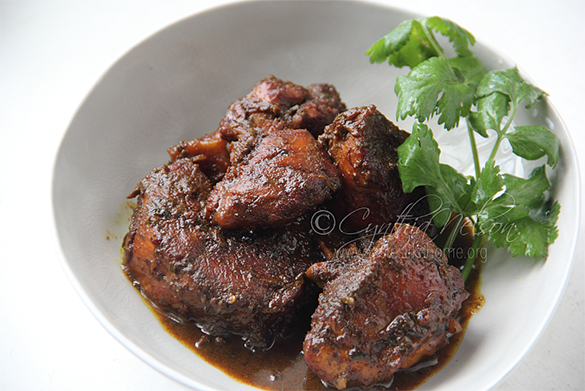 If the headline confuses you, don’t let it, I’ll explain. A few years ago when I first saw the name of this dish on social media, I tilted my head to one side in confusion. What is it, a curry, or a stew? My curiosity did not get the better of me, I just shook my head and sighed (lol). Several times over the past couple of months I have seen the dish show up in one of my social media timelines, so I decided to contact my go-to Trini food aficionado, Felix Padilla of Simply Trini Cooking, to find out just what is Curry Stew Chicken.
If the headline confuses you, don’t let it, I’ll explain. A few years ago when I first saw the name of this dish on social media, I tilted my head to one side in confusion. What is it, a curry, or a stew? My curiosity did not get the better of me, I just shook my head and sighed (lol). Several times over the past couple of months I have seen the dish show up in one of my social media timelines, so I decided to contact my go-to Trini food aficionado, Felix Padilla of Simply Trini Cooking, to find out just what is Curry Stew Chicken.
“It is chicken seasoned with curry and cooked with burnt sugar the way we make our brown stew chicken,” Felix explained. I thought it interesting, but I must admit, not enthusiastically so. Nevertheless, last weekend, I figured I’d give it a try. In conversation with Felix, I explained how I cook curry – a paste made of garam masala, turmeric, ginger, garlic, hot peppers, and fresh herbs is sautéed in hot oil and then the meat added etc. Given the process of making Curry Stew Chicken, I would use the same paste to season the chicken and leave it to marinate. Felix stressed the importance of the meat being given enough time to marinate, a minimum of 4 hours; I asked if overnight would be too long, he said no, so I marinated the chicken overnight.
The following day, having brought the chicken up to room temperature, I heated oil in my Dutch oven pot (a karahi or any heavy bottomed pot would do), and added brown sugar to melt and “burn”. It is important to point out here that burning in this context is not to let the sugar turn black and bitter but to let it melt and become frothy with the edges of the froth starting to darken.
In went the curry-seasoned chicken and it was tossed well to coat with the burnt sugar and cook until all the juices from the chicken evaporated and the pan was dry with just the oil sizzling. Boiling water was then added to the pot. Everything was given a good stir, releasing any stuck-on bits at the bottom and sides of the pan. The Curry Stew Chicken came to a boil and cooked until it reached my desired consistency of a thick sauce.
When I tasted the sauce to check for seasoning (salt) during the cooking process, I found that there were sweet notes from the sugar and of the spices from the curry. Nothing really stood out. When the dish was finished cooking. I let it sit for 15 minutes for the flavours to settle before eating.
It was not a curry. It was not a stew. It was indeed the unique Trinbagonian creation, Curry Stew Chicken. As I ate, my palate was confused, I was eating something that was neither of the other, and personally, I did not like it. I frowned at my plate with the Curry Stew Chicken, cassava, fried okra, and ripe plantains. I literally said to the chicken: make up your mind, you either want to be curried or stewed. Pick a lane!
It is true that dishes like meat curries and stews get better in the days after they are made. I noticed on the following days that I had the Curry Stew Chicken the flavours were not as muddled. The flavour of curry became dominant (understandably so because of the spices); there was a hint of sweetness and the complex notes associated with burnt sugar. Even though the flavours were better developed, the dish still did not do it for me.
I won’t make it again for me personally, but I’d definitely make it again for my Trini friend who ate it and was gushing about its taste of home.
Curry Stew Chicken – it’s different. Give it a try. Remember, as I always say, taste is a personal thing and subjective. You might find yourself loving the dish and adding it to your repertoire.
Cynthia

